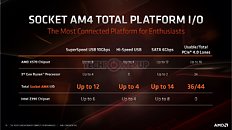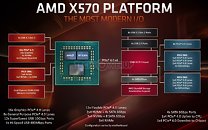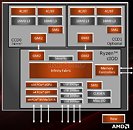Tuesday, June 11th 2019

AMD X570 Puts Out Up To Twelve SATA 6G Ports and Sixteen PCIe Gen 4 Lanes
AMD X570 is the company's first in-house design desktop motherboard chipset for the AM4 platform. The company sourced earlier generations of chipset from ASMedia. A chipset in context of the AM4 platform only serves to expand I/O connectivity, since an AM4 processor is a full-fledged SoC, with an integrated southbridge that puts out SATA and USB ports directly from the CPU socket, in addition to LPCIO (ISA), HD audio bus, and SPI to interface with the firmware ROM chip. The X470 "Promontory Low Power" chipset runs really cool, with a maximum TDP of 5 Watts, and the ability to lower power to get its TDP down to 3W. The X570, on the other hand, has a TDP of "at least 15 Watts." A majority of the X570 motherboards we've seen at Computex 2019 had active fan-heatsinks over the chipset. We may now have a possible explanation for this - there are just too many things on the chipset.
According to AMD, the X570 chipset by itself can be made to put out a staggering twelve SATA 6 Gbps ports (not counting the two ports put out by the AM4 SoC). A possible rationale behind this may have been to enable motherboard designers to equip every M.2 slot on the motherboard with SATA wiring in addition to PCIe, without needing switches that reroute SATA connection from one of the physical ports. It's also possible that AMD encouraged motherboard designers to not wire out SATA ports from the AM4 SoC as physical ports to save costs on switches, and dedicate one of them to the M.2 slot wired to the SoC. With the two SATA ports from the SoC out of the equation, and every other M.2 slot getting a direct SATA connection from the chipset, motherboard designers can wire out the remaining SATA ports as physical ports, without spending money on switches, or worrying about customer complaints on one of their drives not working due to automatic switching. This is an extreme solution to a rather simple problem.The second major component of the X570 chipset is its on-die PCIe switching fabric. The chipset talks to the AM4 SoC over a PCI-Express 4.0 x4 connection (8 GB/s). The chipset has a PCIe root complex that puts out 16 downstream PCI-Express gen 4.0 lanes. This allows motherboard manufacturers to deploy two additional M.2 NVMe slots with full PCIe gen 4.0 x4 wiring, in addition to the slot wired to the AM4 SoC. The remaining lanes can be wired out as U.2 ports, a PCIe x4 (physical x16) expansion slot, and to connect other bandwidth-hungry onboard devices such as 10GbE PHYs, 802.11ax WLAN controllers, Thunderbolt 3 controllers, and USB 3.1 gen 2 controllers.
Speaking of USB, we arrive at the third big thing on the X570, integrated USB 3.1 gen 2. We learn that 3rd generation Ryzen "Matisse" SoCs put out four 10 Gbps USB 3.1 gen 2 ports. Current-generation "Pinnacle Ridge" processors put out four 5 Gbps USB 3.1 gen 1 ports in its place. The X570 chipset adds to this in a big way. Apparently, the chipset puts out a staggering eight 10 Gbps USB 3.1 gen 2 ports (not counting the ports from the SoC), without needing any external controllers. This takes the total USB 3.1 gen 2 port count on the AMD "Valhalla" platform to 12. To put this number into context, Intel Z390 chipset only puts out six USB 3.1 gen 2 ports, none directly from the processor.
AMD finally beats Intel in the PCIe budget numbers-game. The 3rd generation Ryzen "Matisse" processor puts out 24 PCIe gen 4.0 lanes. Add this to the 16 PCIe gen 4.0 lanes from the X570 chipset, and you arrive at 44 lanes (including the chipset bus). This beats the 40 lanes when you combine a "Coffee Lake Refresh" processor with a Z390 Express chipset (16 + 24). It's important to note here that Intel is still stuck with PCIe gen 3.0 on its 9th generation Core platform. The Ryzen "Picasso" APU silicon only puts out 16 PCIe gen 4.0 lanes, hence we arrive at 36 lanes.
According to AMD, the X570 chipset by itself can be made to put out a staggering twelve SATA 6 Gbps ports (not counting the two ports put out by the AM4 SoC). A possible rationale behind this may have been to enable motherboard designers to equip every M.2 slot on the motherboard with SATA wiring in addition to PCIe, without needing switches that reroute SATA connection from one of the physical ports. It's also possible that AMD encouraged motherboard designers to not wire out SATA ports from the AM4 SoC as physical ports to save costs on switches, and dedicate one of them to the M.2 slot wired to the SoC. With the two SATA ports from the SoC out of the equation, and every other M.2 slot getting a direct SATA connection from the chipset, motherboard designers can wire out the remaining SATA ports as physical ports, without spending money on switches, or worrying about customer complaints on one of their drives not working due to automatic switching. This is an extreme solution to a rather simple problem.The second major component of the X570 chipset is its on-die PCIe switching fabric. The chipset talks to the AM4 SoC over a PCI-Express 4.0 x4 connection (8 GB/s). The chipset has a PCIe root complex that puts out 16 downstream PCI-Express gen 4.0 lanes. This allows motherboard manufacturers to deploy two additional M.2 NVMe slots with full PCIe gen 4.0 x4 wiring, in addition to the slot wired to the AM4 SoC. The remaining lanes can be wired out as U.2 ports, a PCIe x4 (physical x16) expansion slot, and to connect other bandwidth-hungry onboard devices such as 10GbE PHYs, 802.11ax WLAN controllers, Thunderbolt 3 controllers, and USB 3.1 gen 2 controllers.
Speaking of USB, we arrive at the third big thing on the X570, integrated USB 3.1 gen 2. We learn that 3rd generation Ryzen "Matisse" SoCs put out four 10 Gbps USB 3.1 gen 2 ports. Current-generation "Pinnacle Ridge" processors put out four 5 Gbps USB 3.1 gen 1 ports in its place. The X570 chipset adds to this in a big way. Apparently, the chipset puts out a staggering eight 10 Gbps USB 3.1 gen 2 ports (not counting the ports from the SoC), without needing any external controllers. This takes the total USB 3.1 gen 2 port count on the AMD "Valhalla" platform to 12. To put this number into context, Intel Z390 chipset only puts out six USB 3.1 gen 2 ports, none directly from the processor.
AMD finally beats Intel in the PCIe budget numbers-game. The 3rd generation Ryzen "Matisse" processor puts out 24 PCIe gen 4.0 lanes. Add this to the 16 PCIe gen 4.0 lanes from the X570 chipset, and you arrive at 44 lanes (including the chipset bus). This beats the 40 lanes when you combine a "Coffee Lake Refresh" processor with a Z390 Express chipset (16 + 24). It's important to note here that Intel is still stuck with PCIe gen 3.0 on its 9th generation Core platform. The Ryzen "Picasso" APU silicon only puts out 16 PCIe gen 4.0 lanes, hence we arrive at 36 lanes.



36 Comments on AMD X570 Puts Out Up To Twelve SATA 6G Ports and Sixteen PCIe Gen 4 Lanes
I am thinking you could use add in cards to get the speed on 3.0 with RAID 0 that you get with 4.0. Or some of the other cool peripherals that PCI_E support. With the falling price of NVME storage you may be able to get a nice 4TB array for less than $300 soon. I also expect 4.0 drives to further drive down the price of 3.0.
For example the X570 Aorus Xtreme has all but the internal Type-C header angled. I was searching the internet for an 90 degree adapter but the best i found were some addon cables for cases like this one from Lian Li: www.lian-li.com/product/pw-ic01nh45/
www.lian-li.com/product/pw-ic2dah85/
For example this one:
www.delock.de/produkte/G_85326/merkmale.html
You can have a look at their website.
On my ASUS Crosshair VII Hero WIFI this USB Type-C front panel port is near to the edge of the board very close to 24 pin power connector which is also striaght.
Below is a picture from inside my 2700x and Radeon VII water cooled system based on ASUS Crosshair VII Hero WIFI. :D
I have a lot of drives and that's the BIGGEST problem I have with too little sata ports on most motherboards , and the fact that 2 of them "died", cause corruption if I try to use them.
This is the final point here for me that seals the deal, so I don't need add-in cards and don't need another server to do all the data management, along with all the other stuff, transcoding, development, true multitasking platform indeed.
I don't know what's going on at AMD but holy crap this is it, but this is just the first step and it's great, keep increasing that IPC, come on, let's go, pesant time is over, time for consumers to get better single core perf we have been waiting for like a almost a decade, go go go !!!
Ofcourse, it's not 100% if I get this generation or the next, but Intel would have to top it far more for me to go back to Intel. Since I do other things, the multi-core stuff is also lovely and if Intel only has like less than 10% higher single-core perf it won't be worth it for me.
@btarunr An extreme solution to a small problem it may be, but if it encourages manufacturers to include more storage ports on all motherboards across the board then it's something that will surely confirm a purchase from me, in this case this is a WELCOMED THING even if it seems overkill, such a pain when I can't use all the space I have in the case (well, I have EATX and never going back)